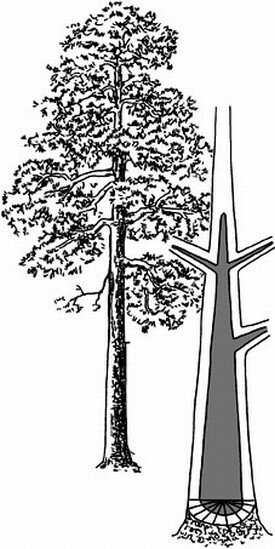
Cross section of a pine tree trunk showing the relationship of the various tissues.
The stem of Scots pine ( Pinus sylvestris L.) consists of two types of wood: sapwood and heartwood. Heartwood is defined as ”the inner layers of the wood, which in a growing tree have ceased to contain living cells, and in which reserve materials, e.g. starch, have been removed or converted into heartwood substances”. In Scots pine, as in many other species, the heartwood extractives function as decay inhibitors. The greater durability of the heartwood than the sapwood in Scots pine is largely due to the presence the stilbenes pinosylvin and pinosylvin monomethyl ether. Since heartwood is more durable than sapwood it is preferred as construction timber in exposed environments. For this reason, we are studying the production and qualities of heartwood, and processes involved in the sapwood-to-heartwood transition. The production of pinosylvin and pinosylvin monomethyl ether is considered to be a key event associated with the transition of sapwood to heartwood. Several enzymes are involved in the synthesis of these stilbenes e.g. stilbene synthetase and phenylalanine ammonialyase, which is also involved in the formation of lignin.

Simplified drawing of a Scots pine tree showing the position of the heartwood.
The main purpose of the studies so far has been to get information about the seasonal changes of protein content and pinosylvin at the sapwood/ heartwood boundary. The studies have been performed on Scots pine trees sampled from a 50-year old stand located 70 km north-west of Umeå. Samples were taken every second week during spring to autumn /97, and less frequently during the winter,from a total of 96 trees for the pinosylvin measurements and 14 trees for the protein analyses. The pinosylvin determinations were performed using FT-(NIR) Raman spectroscopy as described by Holmgren et al. (). The protein contents were determined by a HPLC method of amino acid-analysis frequently used at our laboratory.
Cross section of a pine tree trunk showing the relationship of the various tissues.
Although the between-tree variations in the concentration of pinosylvin at the sapwood/ heartwood border were very large, almost all sampled trees showed a similar pattern. The key feature of this pattern was that the amount of pinosylvin increased considerably at the boundary zone between the sapwood and heartwood, i.e. in a band appr. 1 mm (ca. half an annual ring) from the border, which was visualised by staining. The amount of protein varied between ca. 1.5 and 2.7 mg/g d.w. There was great variation between trees in both pinosylvin and protein content, but it was not possible to trace a specific period during which heartwood was formed. The lack of changes detected in pinosylvin and protein amounts indicates that either there is no special period for heartwood formation, or that the methods used do not give sufficiently precise information about the period of heartwood formation.
Holmgren, A., Bergström, B. Gref, R. & Ericsson, A. () Detection of pinosylvins in solid wood of Scots pine using Fourier transform Raman and infrared spectroscopy. J. Wood Tech. and Chemistry 19: 139-150.
Bergström, B., Gustafsson, G., Gref, R. & Ericsson, A. () Seasonal changes of pino-sylvin distribution in the sapwood/heartwood boundary of Pinus sylvestris. Trees 14:65-71
|